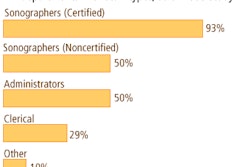Work-related musculoskeletal disorders (WRMSDs) are one of the most prevalent and costly safety concerns in the workplace today, according to the U.S. Department of Labor's Bureau of Labor Statistics.
In sonography, work-related injury poses a serious threat to the health and safety of the worker. WRMSDs can decrease productivity and affect the quality of patient care when workers are performing their jobs in chronic pain. Furthermore, patient safety can be directly affected by the safety and health of the worker through the known effect of WRMSDs on work quality, according to the U.S. Department of Health and Human Services' National Institute for Occupational Safety and Health (NIOSH) (Elements of Ergonomics Programs: A Primer Based on Workplace Evaluations of Musculoskeletal Disorders, March 1997).
There is growing interest among clinical managers to maintain the injured employee in order to retain skilled staff. In addition, complaints of injury are being expressed in the physician workforce, particularly among perinatal specialists who perform ultrasound exams and radiologists utilizing PACS workstations.
Identifying ergonomic hazards through ergonomic workplace assessment provides the opportunity for developing a proactive approach to work safety. The key to a worthwhile site evaluation is for the evaluator to have industry-specific knowledge of the profession for which the workplace evaluation is being performed. In healthcare settings in particular, it is often assumed that the specific training required is minimal due to the industry knowledge that comes from working in the field. But this is not the case in today's complex workplaces.
The training for various professionals often performing site evaluations does not necessarily include ergonomic workplace evaluations. Unless these professionals have pursued training outside their line of work, they may not necessarily have the skills to adequately evaluate a work site. Even with additional training, they still may lack the industry-specific knowledge about sonography.
An evaluation that is considered "participatory" ergonomics is critical to an effective work-site assessment. The primary elements of an effective assessment should include the following (Elements of Ergonomics Programs: A Primer Based on Workplace Evaluations of Musculoskeletal Disorders):
- Identification of a potential WRMSD problem
- Management commitment in the problem-solving process
- Worker and management training in WRMSD risk identification
- Identification of at-risk jobs or work conditions
- Implementation of effective control measures for at-risk workers
- Development of a medical management program for early diagnosis and effective treatment of injuries
- Inclusion of ergonomic principles when planning new work processes, equipment purchases, or work environment design
An alarming rate of work-related musculoskeletal disorders (WRMSDs) among sonographers has been widely established. Research shows that 84% of clinical sonographers experience pain related to their profession. Of those, 20% suffer career-ending injuries, according to a 1999 survey (Journal of Diagnostic Medical Sonography, Vol. 13:5, September-October 1997, pp. 219-227). Workforce shortages are affecting productivity, patient care, and reimbursement revenue. Literature describing WRMSD symptoms goes back as far as the early 1980s; however, little has been done to address the work structure in an effort to break the established paradigm that we now know leads to high rates of WRMSDs.
Ergonomic modifications to work practices and environments have been shown to be effective, but how does an institution convince both staff and management to willingly participate? Too often the division between staff and management has occurred long before the discussion of implementing work safety changes takes place. Management is faced with the challenge of running a fiscally sound department, and staff is resolved to protecting the sanctity of their workday from being overrun with schedules that are out of control and job tasks that create chronic pain.
The reality is that productivity issues have increasingly influenced healthcare in recent years. The focus of the healthcare industry has expanded to not only providing patient care, but running a successful business -- the business of healthcare. Although frustrating at times, the reality is that in order to run a successful business providing health care, institutions must pay attention to the bottom line, a bottom line that is ultimately affected by productivity. Maintaining a highly skilled workforce is an integral part of that bottom line.
The psychology of pain
An integral, yet often overlooked, aspect of risk for occupational injury is the psychosocial component. There are both psychosocial and physical risk factors for work-related injury and multiple related health and productivity outcomes. Breaking the pattern of WRMSDs in sonography requires an understanding by organizations on how they either create or protect against injury risk based on work environments and the workers' perceptions of their required work tasks.
Passive worker participation often occurs as a result of staff feeling they have no control over their work environment. In sonography, this is particularly seen related to issues of staffing and patient scheduling. For example, the simple act of providing daily add-on slots in the schedule and giving sonographers absolute authority over filling those spots can significantly affect the sonographer's impression of workload. Additionally, by giving sonographers the right to reschedule late arrivals, improperly prepped, or incorrectly scheduled patients according to the time constraints of the present schedule has an important psychosocial impact to their overall impression of their work environment.
The practice of sonography requires highly skilled workers with a high degree of self-motivation and responsibility. Effective efforts to improve productivity while addressing risk for WRMSDs must allow for the active involvement of the sonographers. Workers that are directly involved in the job tasks are the crucial element of the work process, and must be motivated to carry out their job with the level of skill and expertise required ("Measuring and Enhancing Productivity," Proceedings of the International Ergonomics Association 2000/Human Factors and Ergonomics Society 2000 Congress, July/August 2000, San Diego).
Efforts to increase demands on productivity in diagnostic medical sonography require sonographers who are highly qualified, widely skilled, flexible, greatly motivated, and self-regulated. Often this is most readily found in the seasoned sonographer who has developed a high level of expertise through years of clinical practice. Unfortunately, these are also often the staff members that experience symptoms of WRMSD due to years of chronic exposure to injury-producing work environments.
Protecting staff before they become injured is the most effective means for addressing the risk for injury and maintaining fiscal continuity. Creating a productive and nonthreatening atmosphere where staff is motivated is dependent on how administrators make use of their workers' expertise and skills. Staff should feel they have the ability to not only provide input, but also ultimately influence decision-making and the implementation of work processes. This balance of practical and psychosocial aspects of the work atmosphere involves creating an environment where department goals and individual responsibilities are understood so that workers can fully utilize their professional skills, yet also have the authority to carry out changes necessary to maintain a safe work environment ("Measuring and Enhancing Productivity").
Defining productivity
Productivity can be described as a measurement of efficiency, with efficiency relating to how well an organization utilizes its resources. Therefore, if we consider productivity in the diagnostic imaging setting, we would take into account the efficiency of the department in terms of output as compared with the number of full-time equivalent (FTE) hours and other related costs expended to achieve that output.
In sonography, the costly issues related to WRMSDs must be addressed in the development of a program to improve productivity and efficiency. Implementing a program of working smarter, not harder, holds the key to improving productivity, staff retention, and morale, while decreasing time loss and workers' compensation expenses by reducing WRMSDs.
How do WRMSDs affect productivity?
Numerous studies have demonstrated the correlation between the development of WRMSDs and working conditions that involve awkward postures and muscular strain. Workers whose job duties require constant muscle strain on specific muscles in the neck and shoulder region are shown to have a high rate of sick time related to WRMSDs. It is also widely accepted that pain is the primary symptom of WRMSDs, according to a study in the journal Applied Ergonomics (September 1984, Vol. 15:3, pp.162-174). Furthermore, pain inhibits the worker's ability to work efficiently and accurately.
The highest rate of WRMSDs among sonographers is related to the neck and shoulder, according to research from the Journal of Diagnostic Medical Sonography (September 1, 1997, Vol. 13:5, pp. 219-227). According to the American Academy of Orthopaedic Surgeons, 80% of people with shoulder disorders are still symptomatic six months after seeking treatment with more than half reporting pain significant enough to interfere with their work as much as three years later. In addition, another 30% of individuals with shoulder injuries ultimately end up leaving their jobs, according to a recent article in Diagnostic Imaging (March 2006, Vol. 28:3, pp. 37-42). Other events impacting productivity as a result of WRMSDs are staff turnover, job dissatisfaction, and staff morale.
How can ergonomics enhance productivity?
A study on the relationship between ergonomic work environments and productivity from a broad cross-section across North America found that absenteeism fell from 4% to 1% after workstation design changes, and employee productivity was subjectively judged as "much improved." Blue Cross Blue Shield found that after implementing ergonomic designs in employee workstations, there was a 4.4% improvement in productivity. A comprehensive ergonomics program at Johns Hopkins Hospital resulted in an 80% reduction in WRMSDs over a six-year period. Intel reported a 72% reduction in WRMSDs over a four-year period after implementing an ergonomics program.
One high-tech manufacturer had a 5% improvement in productivity by implementing ergonomic improvements in the employees' workstations. This increased productivity resulted in a net reduction in staff. In a 2001 survey by Liberty Mutual, 95% of executives whose companies had invested in workplace safety believed that it had a positive financial impact, and 61% claimed a return on investment of $3 or more for each $1 invested in improving workplace safety. Furthermore, the investment stands to have positive effects on productivity and cost containment for many years following.
Ultimately, the manager or employer makes the decision on which approach to take in preventing injuries, supporting the injured worker, and determining the most suitable management of the return to work process. However, there are a number of examples of companies who ultimately decided that their workers were valuable, injured or not, and have taken the steps to include a strong focus on prevention and early intervention to protect their staff. Regarding employees as an investment and taking steps to protect that investment offers not only opportunity for improved productivity, but also employee well-being and morale. Ergonomics provides the foundation for effective management and well-trained workers to perform at their best level, thus supporting optimum patient care, work efficiency, and employee retention.
By Susan L. Murphey
AuntMinnie.com contributing writer
May 17, 2006
Susan L. Murphey is director of operations at Sound Ergonomics, a consulting firm specializing in ergonomics for allied health professionals.
Related Reading
Radiologists can maintain visual acuity in filmless environment, December 29, 2005
Ergonomics -- It's all about you, November 23, 2005
Tackling ergonomic issues in sonography, September 13, 2004
Managing ultrasound ergonomics, March 26, 2004
Work-related musculoskeletal injuries continue to plague rads, August 20, 2003
Copyright © 2006 Sound Ergonomics



















